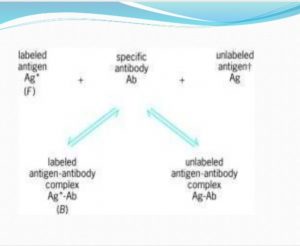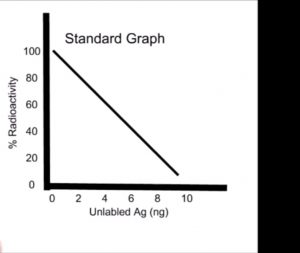RADIOIMMUNOASSAY (RIA):Principle, Procedure, Application and MCQ for GPAT, NET JRF and GATE exam
RADIOIMMUNOASSAY :-
- This techinque is used to determine concentration of antigen in given sample.
- This techinque is very sensitivity it can detected 0.001 μg/ml.
- This techinque was introduced in 1960 by berson & yalow.
PRINCIPLE OF RIA :-
- It involves three principles which make it most specific & sensitive than other immune assays.
- An immune reaction i.e. antigen,antibody binding.
- A competitive binding or competitive displacement reaction
- Measurement of radio emission (it gives sensitivity)

WHAT IS A LABEL ?
All immunoassay require the use of labeled material in order to measure the amount of antigen or anti body present.
A label is a molecule that will react as part of the assay so a change in signal can be measured in the blood : reagent solution.
GENERAL PROCEDURE OF RIA :-
- A known quantity of an antigen is made radio active frequently by labeling it with gamma radioactive isotopes of iodine attached to tyrosine.
- This radio labeled antigen is then mixed with a known amount of antibody for that antigen and as a result the two chemically bind to one another.
- Then a sample of serum from a patient containing an unknown quantity of that same antigen is added.
- This causes the unlabeled anti gen from the serum to complet with the radio labeled antigen for antibody binding site.
- The concentration of cold antigen is increased more of it binds to the antibody displacing the radiolabled variant and reducing the ratio of antibody – bound radio labeled antigen to free radio labeled antigen.
- The radioactivity falls because unlabelled antigen dilute it.
- The count obtained from the radioactivity are used to determine the hapten concentration in the sample the interpretetion being done on the standard curve.
-
Test tube-1 blank Ab +Ag Test tube-2 calibrator Ab+pure Ag + Ag Test tube-3 sample Ab + sample A g + Ag 
REQUIREMENTS :-
- Micro titer plate/ test tube
- Pure antigen
- Radio labelled antigen
- Anti body
- Standards
- Centrifuge
- Radio active counter
- Micro titer plate :- A micro titer plate is used mostly used for this assay. A microtiter plate could have 6,24,96,384 or even sometimes 1536 wells arranged in rows.Each well of a microplate can only hold very small amount of liquid.
- Pure antigen :- Antigen may be obtained from biological sample or by synthetic form it should be pure. It is used as standard or calibrator.
- Radio labelling of antigen :- The most commonly used radiolabels in RIA are tritum and iodine.They have adequate activity and have long enough half lifes.
- Antibody :- sepcific antib0dies are obtained by injecting the Ag to animals.
- Standards :-

- CENTRIFUGE :- Used for the separation of precipitated from and supernatant liquid from. Range : 1200-2500 rpm
- Radio active counters :- two types of counters are used.1.gamma counter 2. scintillation counters
- Gamma counter:- these are used for the gamma energy emitting isotopes
- Scintillation counter :- These are used for counting beta energy emitting isotopes
• Separation techniques :-
- After completion of reaction of reaction free from and bound forms are determined by separation techniques.
- Various technique include gel filtration, electrophoresis, solid phase adsorption of Ag,Ab & fractional precipitate.
APPLICATION OF RIA :-
- RIA is used in the assay of drug like amphetamine,barbiturates,digitoxin,morphine etc.
- In analysis of vitamine like riboflavin,folic acid.
- RIA IS USED TO ASSAY THE PLASMA LEVEL OF FOLLOWING:-
- Digitoxin or digoxin in patients receiving these drugs.
- Certain abused drug.
- It is used to assay the presence of hepatitis B surface anti gen in donated blood.
MCQ
1. Which technique is used to assay drug concentration in plasma ?
A. IR sepctroscopy
B. UV sepctroscopy
C.Non aqueous titration
D. RIA
2.RIA was developed by
A. Berson & Yalow
B. chals & wastone
C. vector&logan
D. lewis & bronstand
3.How many microgram antigen detected in sample by RIA ?
A.0.1 μg/ml
B.0.0001 μg/ml
C.0.001 μg/ml
D.0.01 μg/ml
4.Which sentence is not true about RIA?
A.The most commonly used radiolabels in RIA are tritum and iodine.
B.Centrifugation rpm is 1200-2500.
C.This techinque is very sensitivity it can detected 0.001 μg/ml
D.This techinque is very sensitivity it can detected 0.01 μg/ml
5.RIA standarded graph as
A. X-axis = % Radioactivity and Y.-axis = unlabled Ag(ng)
B.X-axis = unlabled Ag(ng) and Y.-axis = % Radioactivity
C.X-axis = % Radioactivity and Y.-axis = unlabled Ag(mg)
D.X-axis = Radioactivity and Y.-axis = unlabled Ag(ng)
6.Which is not application of RIA ?
A.It is used to assay the presence of hepatitis B surface anti gen in donated blood.
B.In analysis of vitamine like riboflavin
C. T4 & T3 measurement
D.Digitoxin or digoxin in patients receiving these drugs and measurement its concentration.
ANSWER KEY :-
1. D
2.A
3.C
4.D
5.A
6.C
Participate in Online FREE GPAT TEST: CLICK HERE
Participate in Online FREE Pharmacist TEST: CLICK HERE
Participate in Online FREE Drug Inspector TEST: CLICK HERE
REFERENCE :-
Textbook of microbiology by Prescott, Harley.
Practical analytical chemistry by BECKEET.